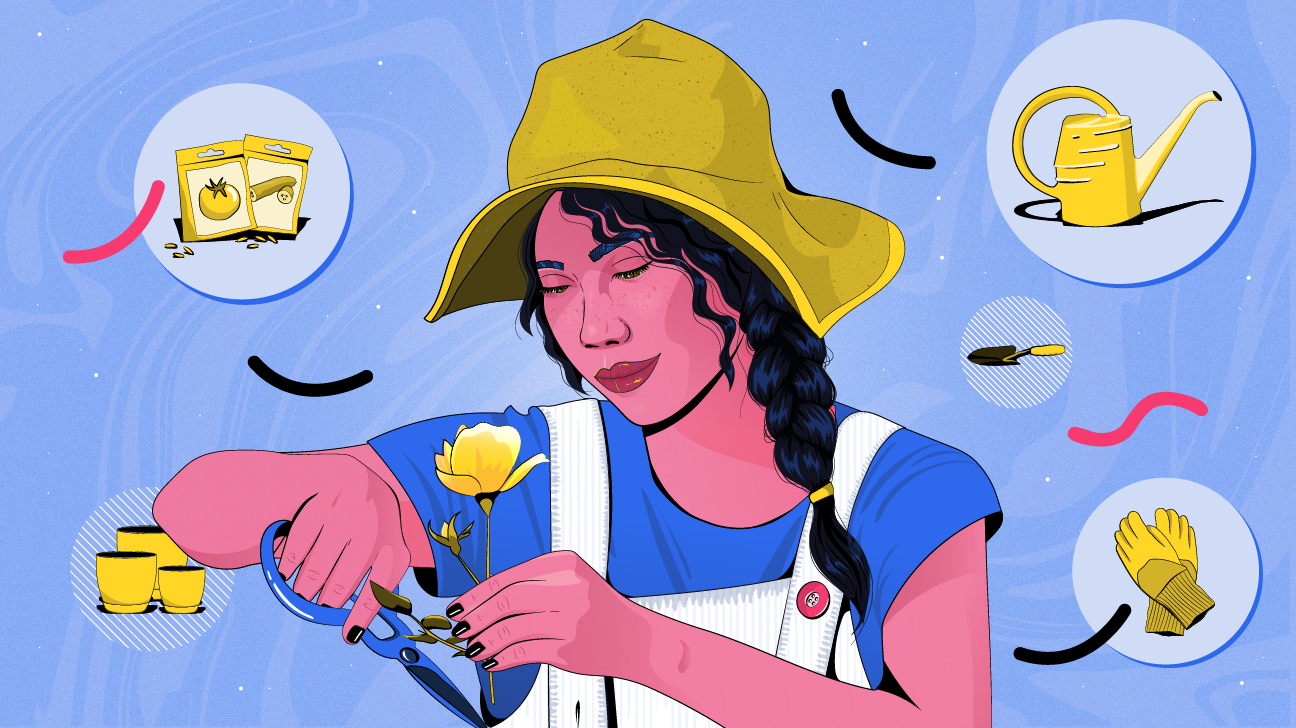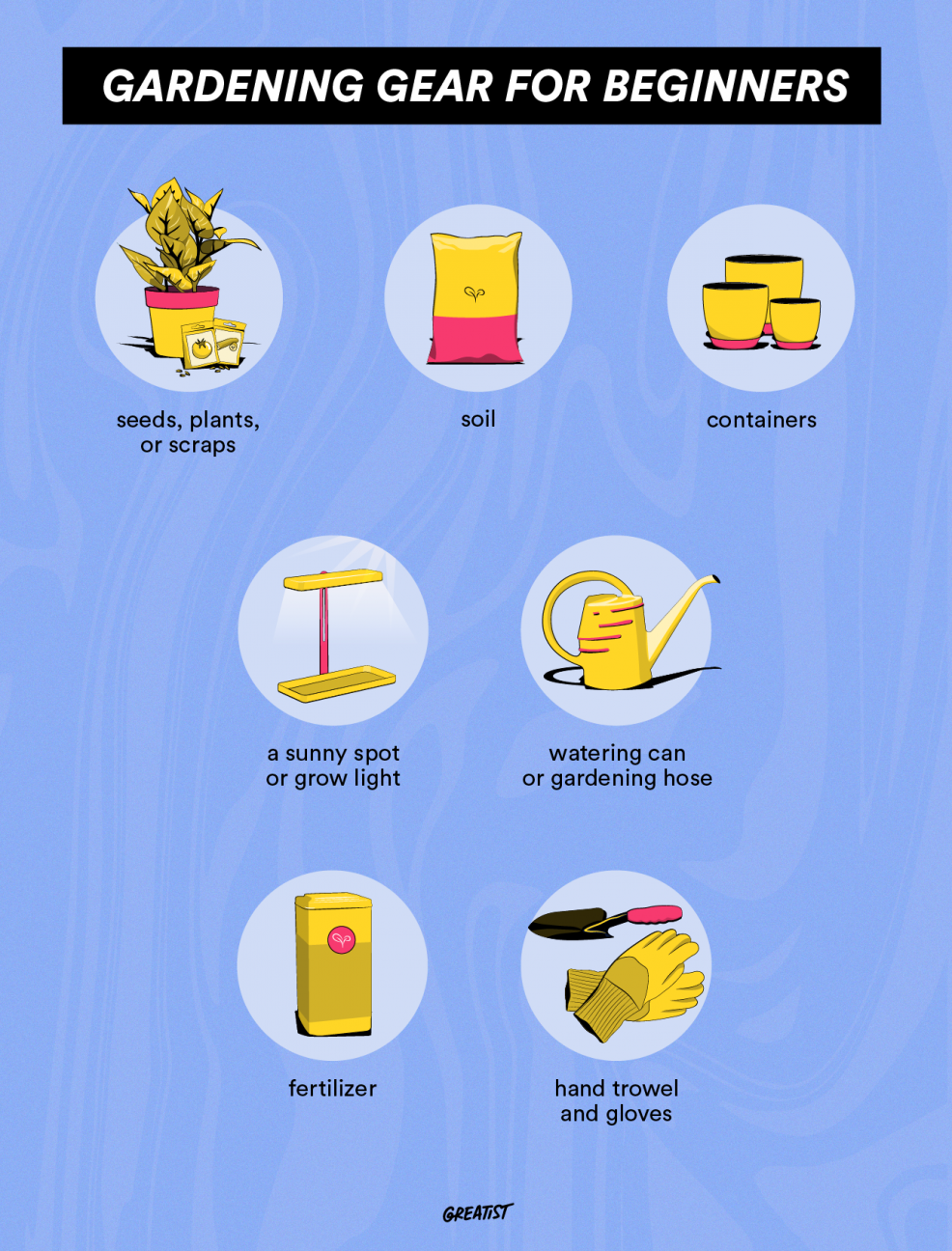Let’s not *beet* around the bush: starting a garden can be intimidating, especially if your previous experiences trying to keep plants alive have straight up succ’d.
But here’s the good news: it doesn’t have to be as complicated as we try to make it. When it comes down to it, all you need for your plants to thrive is sunshine, water, and dirt.
So there’s no need to be green with envy over your neighbor’s green thumb. Here’s how you can get into gardening right now, even if you’ve never grown anything except older. Lettuce begin!
Gardening starter pack
- seeds, plants, or scraps
- soil
- containers
- a sunny spot or grow light
- watering can or garden hose
- fertilizer
- hand trowel and gloves

How to get started and advice for newbies
To make sure we didn’t give you some 💩 advice (although it makes great fertilizer), we spoke to the Guardians of the Garden: a handful of registered dietitians who really know (and grow) their stuff. Here’s their essential advice for growing flowers, veggies, fruit, and herbs — whether you’ve got a big ol’ yard or a tiny little windowsill.
Container gardening
Feeding the Root founder, farmer, and dietician Samaria Grandberry says, “For people who are just getting started gardening without a lot of space, I would say start with a container garden or windowsill garden.”
And Bri Bell, the dietitian and windowsill gardener behind Frugal Minimalist Kitchen, explains how easy it is to get started with container gardening. “I started growing green onions indoors with the absolute bare minimum: a glass of water, a sunny windowsill and green onions from the store,” she says.
Outdoor gardening
And although container gardening may be a better fit if you’re an absolute newbie or if you don’t have a patch of grass to your name, it can be just as simple to get started with outdoor, straight-in-the-ground gardening — especially if you’ve got good soil. No need to buy containers, either!
However, warns Grandberry, plants that are outside taking in hours of direct sun every day are gonna need lots more water. Something to consider!
As you get more comfortable with outdoor gardening, you may want to up your gardening game with raised beds, a greenhouse, or an irrigation system, but as a beginner these things aren’t essentials.
Indoor gardening
By nature, indoor gardening is automatically gonna be container gardening. But Bell, who lives in a basement apartment herself, reassures us that it’s more than possible. “It’s great for fresh herbs year-round,” she explains, adding, “As long as you have a window that gets at least 4 hours of direct sunlight (or are willing to invest in a grow light), you can have success growing shade tolerant herbs and veggies in your apartment windowsill.”
As Bell mentions, you may need a little more equipment to be really successful at indoor gardening unless you only plan to regrow food scraps. You may need a grow light if you don’t have a sunny window, and you’ll need containers and soil too.
Finally, adds culinary dietitian, cookbook author, and hydroponic gardener Wendy Jo Peterson, don’t be afraid to ask for help! “The local USDA extension office is a great place to start for classes and information about your specific area,” she explains. Grandberry recommends linking up with some online communities centered around your preferred type of gardening, like Facebook groups. Even Reddit can be super helpful — r/plantclinic is essentially an open source, online plant ER.
However you choose to get started though, we’ve got all the deets on what you’ll need to ~blossom~ right here.

The gear you need and why you need it
Seeds, plants, or scraps
You can buy all the fancy gardening stuff you want, but if you don’t have something to grow your efforts will be — wait for it — fruitless.
But what should you start with?
“In general,” explains Bell, “it’s a bit easier to grow foods where you eat the leaves, like spinach.” She says that this is because root veggies and fruiting plants will take more time to grow — meaning there’s more time for things to go wrong before you’re able to harvest. But if you want to give root veggies or fruiting plants (or flowers) a try, go for it!
Peterson says, “Easy gardening plants include parsley, peas, lettuce, and carrots.”
And if you’re wanting to start ASAP without having to buy anything, Bell recommends starting with green onion scraps (the white ends with roots sticking out) in a cup in your windowsill with some water. “You don’t even need soil to regrow green onions,” she explains. “You can also regrow celery or lettuce like this too.”
Soil
If you’re starting a container garden, you’re gonna need to pick up a bag or two of potting soil. Fortunately, most potting soils are clearly labeled for the type of plant they’re best for, so it’s easy to find what you need — or an all-purpose potting mix will work just fine, too.
If you’re planting direct-to-dirt, you don’t even have to buy soil! However, Peterson recommends doing a dirt health check if you’re having trouble getting your garden to thrive. “Check your soil pH,” she recommends, “because If your pH is off it can be frustrating.” If you’re planting veggies, you want your soil pH to be between 5.8 to 6.5, or slightly acidic, according to the Clemson Cooperative Extension.
Containers
For your container garden, you’re gonna need plenty of containers (obvi). Make sure they’ve got drainage holes in the bottom to allow extra water to drain out. The most common planters are made from terra cotta or plastic, but if you need some bigger ones you can buy some cheap 5-gallon buckets from a hardware store and drill holes in the bottom.
“Dollar Tree has lots of very affordable pot options of all shapes and sizes,” suggests Grandberry. She adds, “As a beginner you might not want to spend lots of money, so purchasing pots at the Dollar Tree can save you money.” And you know we’re all about (saving) the Benjamins, baby. PS, if you don’t have Dollar Tree in your area, check your local 99-cent store.
A sunny spot or a grow light
All right, you got plants, dirt, and containers — now it’s time to get lit. Sunlight is your plant’s favorite food — in fact, they’re strict solar-tarians.
Plant your outdoor veggie garden in a spot that gets lots of direct sun, and find the sunniest windowsill in your home for your windowsill garden (north of the equator, that’s gonna be a south-facing window).
If you’re surrounded by shade, try more shade-tolerant plants. Outdoors, root veggies and leafy veggies can do well in semi-shaded areas as long as they get a few hours of sun every day. Flowering plants need more sun, though.
And if you’re an indoor gardener…
“As long as you have a window that gets at least 4 hours of direct sunlight (or are willing to invest in a grow light),” Bell explains, “you can have success growing shade tolerant herbs and veggies in your apartment windowsill!” Aloe, chives, and mint can do well in a semi-sunny ‘sill even if you don’t get a ton of light in your house.
Alternatively, get yourself a grow light and grow whatever you want, wherever you want! They’re not just for the herb, they’re for herb gardens too (although they can pull double duty *wink wink*).
Watering can or garden hose
Your plants are also gonna need water. While some plants will need more and some plants will need less, a general rule of thumb is to water when the top layer of dirt or soil is dry. Remember Grandberry’s advice: veggies like lettuce, tomato, and cucumbers that are outdoors in full sun will need more water than, say, beans or hardier herbs (like rosemary).
Outdoors, it’ll be easiest to water your garden with a hose, but if you’ve got a container garden or an indoor garden you may want a watering can. You can save money and use a cup or an empty milk jug if you want to (or just taking your plant on a field trip to the sink) — as long as you’re gentle, your plants won’t mind.
Fertilizer
Plants love poop. It is what it is. “If you’re able,” suggests Grandberry, “look for a local farm and ask the farm for manure! It’s an amazing organic fertilizer.”
If you can’t handle the poo, Peterson also recommends compost to add nutrients to your soil.
She’s fond of mushroom compost, which you can buy online — but it’s also got some manure in it. Alternatively, get yourself a compost kit and start saving your (nonmeat and nondairy) food scraps! DIY composting at home is also a great way to cut down on food waste.
Hand trowel and gloves
“Your hands are your best tool,” explains Peterson, but she recommends a trowel and gloves to protect those hands (JIC you grab a handful of poison ivy while pulling weeds) or keep ’em clean (for instance, if you just got a fresh mani).
Grandberry says, “It’s very easy to get caught up in all of the latest and greatest gardening gadgets,” but these basic tools should be more than sufficient for a small beginner garden. Of course, if you decide you like this gardening thing you can buy more tools. When it comes to how many gizmos you can buy for your garden (and how much $$$ you can spend), the limit does not exist.
tl;dr
If you’re new to gardening, it’s insanely easy to get bogged down in the weeds of uncertainty and overplanning. But gardening can be easy with just a few basic tools. Remember, plants want to grow! Grandberry puts it best when she says, “Plants were made to grow, it’s in their DNA. Give them the basics — water, food, soil, and sunlight — and most of the time they’ll take care of the rest.” So, no more overthinking it — just get growing!

0 Commentaires